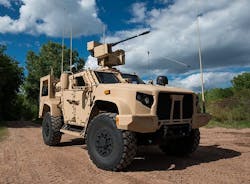Military closer to developing smart bullets for machine guns on ships, vehicles, and aircraft
Machine guns strictly represent a curtain of firepower in one direction; it doesn't much matter that most of the bullets miss their targets, as long as a few manage to hit home.
Now military researchers are trying to stand the concept of the traditional machine gun on its head, adding precision and intelligence to the mix, by enabling each bullet fired to home-in on its target independently of the others, with the ability its change its path in mid-flight to engage rapidly maneuvering targets.
Think of a weapon that offers the rapid-fire capability of a machine gun with the precision independent targeting of a guided missile, and you have the Multi Azimuth Defense Fast Intercept Round Engagement System (MAD-FIRES) program of the U.S. Defense Advanced Research Projects Agency (DARPA) in Arlington, Va.
This project is expected to yield enabling technologies for rapidly fired smart bullets at separate targets roughly in a 180-degree half-sphere field of fire to detect swarms of manned and unmanned aircraft, fast attack boats, quickly maneuvering land vehicles, or other massed attacks.
Related: Raytheon to build prototype smart bullets to protect surface warships from swarming attacks
The Raytheon Missile Systems segment in Tucson, Ariz., and the Lockheed Martin Corp. Missiles and Fire Control segment in Grand Prairie, Texas, are working on the MAD-FIRES program for DARPA. The two companies have completed concepts, simulations, and risk reduction.
Late last week DARPA scientists asked Raytheon to move the program forward to the prototype stage that is expected over the next year to test and validate MAD-FIRES technologies in realistic battlefield conditions. Lockheed Martin most likely also will take its MAD-FIRES work into the prototype stage.
The most promising and immediate potential application for MAD-FIRES technology is for the Bushmaster MK 38 25-millimeter deck gun aboard U.S. Navy destroyers and other surface warships for defending against small, fast, and agile surface threats.
A 25-millimeter bullet is about six inches long and nearly an inch in diameter. Each bullet can have a high-explosive or armor-piercing penetrator for use against vehicles, personnel, light fortifications, or similar targets. The MK 38 can fire these bullets at rates between 200 and 500 rounds per minute. It can cause a lot of damage.
Now consider if each of those 200 to 500 rounds per minute could be directed at a separate target, with the ability to change its trajectory in flight to avoid attempts at evasion. Even large combined swarms of fast attack boats, manned aircraft, and unmanned aerial vehicles (UAVs) bearing down on a Navy surface ship would have little chance at survival, much less of damaging the ship.
The 25-millimeter auto cannon, moreover, isn't limited just to Navy surface warships. The M242 Bushmaster, on which the MK 38 deck gun is based, also can be fitted to armored combat vehicles like the M2 Bradley.
It's reasonable to guess that MAD-FIRES-equipped machine guns also could be fitted to fighter and land-attack aircraft, fast and light military vehicles such as the Army Joint Light Tactical Vehicle (JLTV), special operations boats, and other military platforms.
Medium-caliber machine guns with independently targeted smart bullets. They could be coming to a variety of military platforms perhaps as early as over the next decade.
Learn more: search the Aerospace & Defense Buyer's Guide for companies, new products, press releases, and videos

